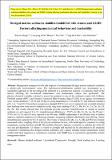Dredged marine sediments stabilized/solidified with cement and GGBS: Factors affecting mechanical behaviour and leachability
Date
2020-04-08Author
Zhang, Wan-lu
Zhao, Lun-yang
McCabe, Bryan A.
Chen, Yong-hui
Morrison, Liam
Metadata
Show full item recordUsage
This item's downloads: 311 (view details)
Cited 10 times in Scopus (view citations)
Recommended Citation
Zhang, Wan-lu, Zhao, Lun-yang, McCabe, Bryan A., Chen, Yong-hui, & Morrison, Liam. (2020). Dredged marine sediments stabilized/solidified with cement and GGBS: Factors affecting mechanical behaviour and leachability. Science of The Total Environment, doi:https://doi.org/10.1016/j.scitotenv.2020.138551
Published Version
Abstract
Management strategies for the safe disposal of contaminated dredged marine sediment are a global scale environmental issue. Stabilization/solidification method was investigated as a sustainable approach for the potential recycling of the sediment as a construction material. A systematic study of the factors affecting the mechanical performance and contaminant release was performed. The physicochemical variables selected to assess the potential re-use of the sediment treated with Ordinary Portland cement (OPC) and Ground Granulated Blast Furnace Slag (GGBS) in an aquatic environment were: curing duration (7, 28, 56 and 98 days), curing temperature (5, 20 and 40 °C) and ambient (leachate) pH (1, 4, 7 and 10). Unconfined compressive strength (UCS) tests were conducted and extended-duration tank leaching tests were used to characterize the long-term leaching of Al, Cr, Mn, Fe, Ni, Cu, Zn, As, Cd, Ba, Pb. The results showed that S/S methods provide excellent immobilization of metals in marine sediment at a pH range of 4 to 10. Immobilization efficiencies of >99.9% for Mn, Fe, Zn, As, Ba, Pb and >97.8% for Al, Cu and Zn are reported over 100 days. GGBS replacement is an effective way to further improve sediment properties by enhancing strength, mitigating sediment alkalization and offering a better immobilization capacity for Fe, Ni and Zn. The release of metals (Al, Mn, Cu, As, Ba and Pb) was strongly associated with a coupling effect of the physicochemical factors, with metal-specific responses to curing temperature, curing duration and pH. Mn mobility showed a dramatic sensitivity to ambient pH while Ba was less pH-dependent. Al release is related to strength and leached out by dissolution in any cases. Considering that dredged marine sediments may contain multiple metal contaminants which exhibit individual responses to remediation, treatment with GGBS can be considered a potentially suitable management option.


